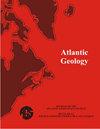The Lac au Renard Tephra Cluster: a record of Lochkovian (Lower Devonian) volcanism in the Indian Point Formation, Gaspe Peninsula, Quebec, Canada
IF 0.9
4区 地球科学
Q2 GEOLOGY
引用次数: 0
Abstract
Approximately twenty tephra beds, comprising the Lac au Renard Tephra Cluster (new), occur in the Rosebush Cove and Petit Portage members of the Indian Point Formation (Chaleurs Group) on the Gaspe Peninsula of Quebec, Canada. The tephra beds range in thickness from <1.0 cm to 82 cm and occur in a mudrock-dominated sequence with coarser tempestite interbeds. Mineralogically and texturally graded accumulations of phenocrysts mark the bases of the thickest tephra beds. Early diagenetic concretions in one composite tephra preserve pre-compaction fabrics and original hypocrystalline textures with microphenocrysts and devitrified glass shards. The presence of plagioclase, quartz, K-feldspar, biotite, apatite, and zircon suggest a rhyolitic source. The coarseness of the microphenocrysts in the basal accumulations, along with the abundance and thickness of the tephras, suggest that deposition in the Gaspe area was in a proximal position relative to the volcanic source. The zonal graptolites Monograptus praehercynicus and Monograptus aequabilis ssp. from the Petit Portage Member indicate a middle Lochkovian age for the Lac au Renard Tephra Cluster of the Indian Point Formation. Correlation with the tephra cluster that includes the Judds Falls Bentonite in the New Scotland Formation and other possible tephras in the Kalkberg Formation (Helderberg Group) of New York and the Corriganville and Mandata formations of Pennsylvania is likely. The graptolite fauna of the Indian Point and probable correlations to New York may provide additional biostratigraphic constraints on a U–Pb zircon radiometric age determination of 417.6 Ma from New York that has been used to estimate the age of the Silurian–Devonian boundary.Lac au Renard Tephra群:加拿大魁北克省加斯佩半岛印第安点组Lochkovian(下泥盆世)火山活动记录
加拿大魁北克省加斯佩半岛印第安角组(Chaleurs群)的Rosebush Cove和Petit Portage成员中,约有20个火山床,包括Lac au Renard tephra群(新)。火山灰岩层厚度在<1.0 cm至82 cm之间,以泥岩为主,具有较粗的风暴岩互层。斑晶的矿物和质地分级堆积标志着最厚的火山灰岩层的基底。一个复合火山灰岩中的早成岩结核保留了预压实组构和原始的次晶结构,具有微晶和失透玻璃碎片。斜长石、石英、钾长石、黑云母、磷灰石和锆石的存在表明其来源于流纹岩。基底堆积物中微晶的粗糙度,以及火山灰岩的丰度和厚度,表明加斯佩地区的沉积相对于火山源位于近端位置。带状笔石Monograptus praehercynicus和Monograpus aequabilis ssp。来自Petit Portage段,表明印第安角组Lac au Renard Tephra群的Lochkovian中期。可能与包括新苏格兰组的Judds Falls膨润土和纽约Kalkberg组(Helderberg群)以及宾夕法尼亚州Corriganville和Mandata组的其他可能的火山灰岩的火山灰带群相关。Indian Point的笔石动物群以及与纽约的可能相关性可能会为纽约417.6 Ma的U–Pb锆石辐射年龄测定提供额外的生物地层学限制,该年龄测定已用于估计志留纪-泥盆纪边界的年龄。
本文章由计算机程序翻译,如有差异,请以英文原文为准。
求助全文
约1分钟内获得全文
求助全文
来源期刊

Atlantic Geology
GEOLOGY-
CiteScore
2.10
自引率
18.80%
发文量
0
审稿时长
>12 weeks
期刊介绍:
Atlantic Geology (originally Maritime Sediments, subsequently Maritime Sediments and Atlantic Geology) covers all aspects of the geology of the North Atlantic region. It publishes papers, notes, and discussions on original research and review papers, where appropriate to the regional geology.
 求助内容:
求助内容: 应助结果提醒方式:
应助结果提醒方式:


